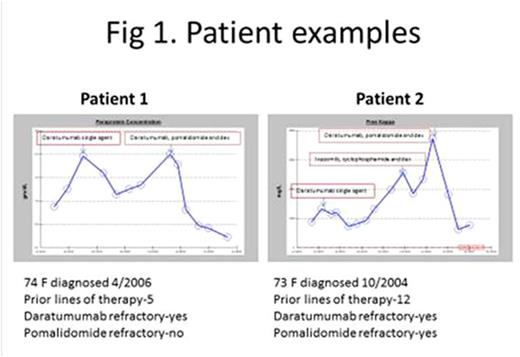Abstract
Introduction: Daratumumab (DARA) is a human CD38-directed monoclonal antibody, recently approved by the FDA for treatment of myeloma patients that have received ≥3 prior lines of therapy including a proteasome inhibitor and an immunomodulatory agent. DARA has demonstrated excellent clinical activity in combination with pomalidomide (POM) and dexamethasone (D) (Chari et al ASH 2015) among relapsed (R) or relapsed and refractory (RR) myeloma patients. While DARA is being evaluated in combination with several backbone therapies among patients who are naïve to DARA or the backbone agent under evaluation, its utility is unclear among patients refractory to DARA or the combination agent.
Methodology: We report our experience of the combination of DARA-POM-D among patients that are naïve to DARA and POM (cohort 1), that were refractory to DARA or POM (cohort 2) and that were refractory to DARA and POM (cohort 3). We performed a retrospective evaluation of patients with relapsed or R/RR myeloma treated at Emory University Hospital from January 2015 until July 2016. Responses were evaluated using the IMWG criteria. We used IBM SPSS version 23.0 to generate the survival statistics.
Results: Among the 41 patients (39% M/61% F) included in analysis, the median age at the time of receiving the DARA-POM-D regimen is 63 years (range 32-92). 61% of the patients had IgG isotype, 15% had ISS stage 3 disease at diagnosis. 97% were lenalidomide refractory, 86% were bortezomib refractory and 90% underwent SCT. 19 patients (46%) that received the DAR-POM-D regimen were naïve to both DARA and POM while 12 patients (29%) were refractory to both DARA and POM. More than half of the cohort (54%) in cohort 2 were refractory to either DARA or POM. The median prior lines of therapy (cohort 1: 2: 3- 3: 5: 6.5 prior lines) and median time to initiate DARA-POM-D regimen from diagnosis (cohort 1: 2: 3- 72: 65: 57 months) suggested cohort 3 is a heavily pretreated group. High risk cytogenetics for cohort 1: 2: 3 were 15.8% vs 31.8% vs 25%, respectively. The response rates and the median progression free survival (PFS) are summarized in table 1.
Conclusions: Our analysis shows impressive overall response rates of close to 90% among DARA and POM naïve patients. More importantly, overall response rates of close to 35% were seen with DARA-POM-D regimen among patients that are refractory to both DARA and POM. While recapturing the responses with combination therapy DARA-POM-D among patients that are refractory to the individual agents (Figure 1) is provocative, a clear biological rationale should be investigated, which potentially can guide us to design more optimal combination salvage strategies.
Nooka:Spectrum, Novartis, Onyx pharmaceuticals: Consultancy. Kaufman:Celgene: Consultancy, Research Funding; Novartis: Consultancy, Research Funding; Incyte: Consultancy; Pharmacyclics: Consultancy. Lonial:Onyx: Consultancy; Celgene: Consultancy; BMS: Consultancy; Celgene: Consultancy; Merck: Consultancy; BMS: Consultancy; Novartis: Consultancy; Onyx: Consultancy; Janssen: Consultancy; Janssen: Consultancy; Novartis: Consultancy; Millenium: Consultancy.
Author notes
Asterisk with author names denotes non-ASH members.



This feature is available to Subscribers Only
Sign In or Create an Account Close Modal